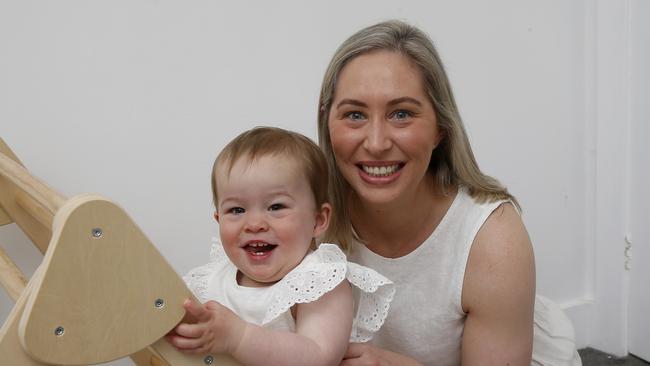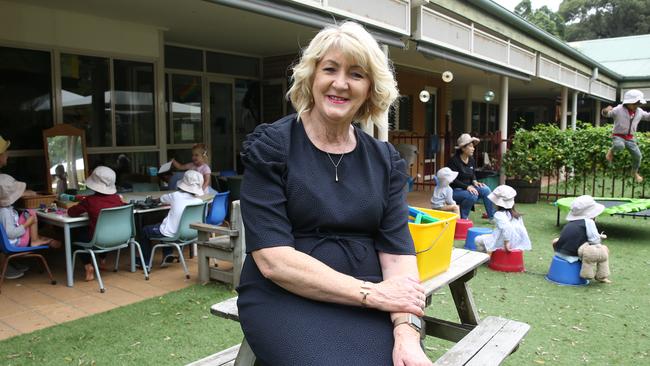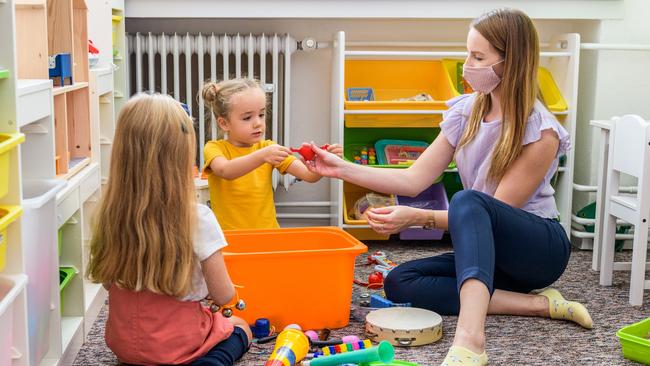Families face long waitlists and high costs for childcare on north shore
The high cost of childcare, long waitlists and service closures make returning to work a sometimes insurmountable challenge for parents on the north shore.
North Shore
Don't miss out on the headlines from North Shore. Followed categories will be added to My News.
Sarah Hughes and her husband Steve are both successful professionals. She works in corporate real estate and he works in finance. But there’s no denying paying $185 a day four days a week to send their one-year-old daughter Madilyn to childcare hurts their bottom line.
“I can’t even begin to think how we will manage should we have two children in daycare,” Hughes says.
Hughes, who is also a Mosman councillor, says the high cost of childcare and long waitlists present serious challenges for parents who are trying to navigate the delicate balance of returning to work and securing quality care arrangements for their children.
“For some parents, the cost of childcare means a return is not financially viable,” she says. “One parent will generally put their career on hold. When we consider the current skills shortage in our workforce, my view is that more needs to be done to ensure parents feel encouraged and supported to return to work, should they wish to. Surely this would have a beneficial impact on the economy.
“This conundrum is compounded by the fact that many families also don’t qualify for government paid parental leave.”

Despite the high sums parents pay for childcare, Hughes says educators working in the sector aren’t well paid. She believes the federal government should consider increasing funding to centres to offset an increase in staff costs and reduce overall centre overheads.
“This would likely help with staff attraction and retention and be hugely beneficial for all our children,” she says. “The government needs to consider a system that is fair and equitable for all.”
One of the last affordable childcare options in the area, Mosman Occasional Childcare Centre, closed its doors in 2019, despite opposition from parents. The centre at Allan Border Oval pavilion, which allowed one day per week childcare, was replaced with a sporting centre.
At the time, council said demand appeared to be quite low and the area was well-served for long daycare.
Council also provides the premises for Jack and Jill Kindergarten Mosman and Northern Nursery School.
“We are fortunate to have so much choice in terms of playgroups, long daycare, occasional childcare and preschools,” Hughes says.

Early Childhood Australia national president Chris Legg agrees affordability is a major issue for families. Chris is also chief executive of KU Children’s Services, which operates several services on the North Shore, including KU Killara Park Preschool, KU Cammeray Preschool and KU Grandstand Kids Care at North Sydney.
“Fees differ greatly,” she says. “Some charge incredibly high fees and others don’t, and it’s because different operators have different costs.
“Early education is really complex, and I think sometimes it’s unfortunate that it’s always referred to as childcare. It’s seen as a strategy to get women back to work, and while that’s important, I think what’s underplayed is the importance for the children. Research shows the wiring in the brain occurs in the first five years of a child’s life.”
Australian, state and territory governments share responsibility for funding and managing arrangements with early childhood service providers.
“The federal government funds long daycare and out-of-school-hours care, and the state government funds preschools, so there’s obviously a difference between the funding,” Legg says. “Through Covid, the commonwealth government said that organisations can waive gap fees for Covid-related absences. Last year they gave us some financial support to do that but this year that hasn’t occurred, so that’s a real cost to operators.
“The state government has made preschool free this year. It’s capped at 15 hours and two days a week. That has led to very long waiting lists.

“Next year, preschool will move on to a new funding model. It will be a lot more affordable than long care, but again it’s capped, which is not suitable for a lot of families.”
As a result, many parents end up sending their children to two different service providers, which Legg believes presents other problems.
“Families are using all sorts of different patterns to suit their needs and make it affordable,” she says.
“They spend some of their time in long daycare, but they go to a preschool for two days for free. It would be better for them to be in one service.
“Children under five years old are at the point where they’re learning to relate to other people outside their home. Consistency and stable relationships and attachment are really, really important. It would be like us going to work in different places.
“The NSW government has announced a wonderful 10-year plan that will provide very affordable preschool for all children up to five days a week, which is an amazing initiative.”
Out-of-school-hours care services, for primary school students from kindergarten to year 6, are also facing challenges. In July, Willoughby City Council was forced to close Bales Park Out of School Hours (OOSH) centre at North Willoughby, as well as outsourcing management of the Devonshire Street Children’s Centre at Chatswood.

The decisions followed a review that sought to identify under-utilised, loss-making or non-core services provided by the council that could be delivered by other organisations. The council said Bales Park was attended by an average of 16 children a day – less than half the 45-space capacity – and there were several other OOSH providers that had adequate vacancies to accommodate those children.
“The relatively low demand reflects the fact that more people are now working from home and the fact there has been an increase in the number of competing services located on school grounds,” the council noted.
It decided to keep the other two OOSH services it funds, at Artarmon Kids Cottage and Chatswood Oval, with improvements to reduce costs and to share resources across the services.
Willoughby mum Fiona Morphett, whose two children, aged six and eight, attended the Bales Park service, was outraged by the closure, saying none of the other providers offered comparable outdoor recreation space or the teacher-to-child ratios that kids needed.
“Of the after-school care places offered for Willoughby Public students, Bales Park was the only one that exceeded expectations under the National Quality Framework,” she says.
“One of my kids has special needs, so the idea of 90 kids in a school hall after a day of school doesn’t work. The other one didn’t like the idea of going into that environment either. I think it’s because they had experience of a very, very good centre with carers who knew them and everything about them. It was like another home.”

Morphett ended up changing her work arrangements so her children no longer attend out-of-school-hours care.
“I’m lucky that I’m in a position where my job is flexible,” she says. “There was also a single mum impacted whose kids were there five days a week, and she didn’t have a car. The other options were further afield and she wouldn’t have got there in time for pick-up. One only had two days available.
“The council needs to do better for the community they serve. We weren’t even given the chance to keep the service going for our kids.”


